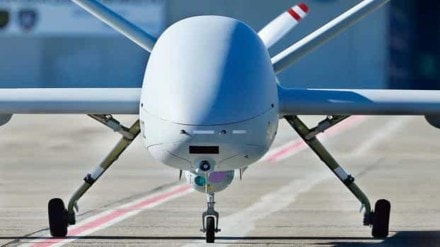By Girish Linganna
Modern warfare drones have proved to be effective weapons, affecting the result of battles. Some defence analysts think low-cost combat drones might replace many current aircraft with a crew. Elon Musk, the founder of SpaceX, is convinced that in the future, all fighters will become unmanned.
Lieutenant General John Thompson, chief of the Center for Space and Missile Systems, questioned inventor Elon Musk during an interview at the US Air Force Air Combat Association conference on what path military aviation would go. Musk’s response startled his audience.
He said that autonomous drones are unquestionably the future of air combat. This, he said, is not his vision; rather, it is a truth and the future. He said that the age of fighter planes is coming to an end and that the time for drones has arrived.
Later, he explained on social media that unmanned fighters easily beat the most advanced American F-35 fighter.
Despite their flaws, Elon Musk considers fighter drones to be quite promising. Drones offer various significant benefits over airplanes, and their deployment will also save pilots’ lives.
Theoretically, UAVs are more maneuverable since they are not subject to overloading constraints. Furthermore, drones are far less expensive than airplanes. In addition, they do not need extensive and costly pilot training. This enables the deployment of fighter UAVs in circumstances where it would be impracticable to endanger a pilot or an expensive aircraft. Therefore, the introduction of drones would increase the military’s capabilities. However, Elon Musk’s prediction that drones would replace combat planes remains uncertain.
The counter
In an essay published by Breaking Defense, Mark Ganzinger, director of advanced weaponry and prospective evaluations at the Mitchell Institute for Aerospace Research, argues that drones are not a substitute for combat aircraft. An expert from the United States feels drones are an important addition to crewed aircraft. According to him, the air force needs a mix of uncrewed aerial vehicles of the next generation, including strike systems and planes of the fifth generation. Future military operations will benefit most from their collaboration.
At the same time, he argues that it makes no sense to attempt to upgrade drones to the level of combat planes. Not only would this raise the price of drones, but it will also needlessly complicate their operation. In the end, the UAV’s appeal rests in its comparatively inexpensive cost, great range, and size that permits flying without a runway.
A modern jet fighter pilot is considered one of the most difficult military professions. To master it, you need many years of training, the ability to make the right decisions, and instantly impeccable reflexes. No matter how perfect artificial intelligence is, it cannot yet replace the flexible human mind.
But, even if artificial intelligence will eventually be able to conduct air combat on its own, another problem has not been solved – the possibility of intercepting drones. Almost every army in the world has means of interception.
Moreover, the enemy can not only take control and land the UAV but also disrupt the operation of its software.
In general, there are many means to “break”. For example, aiming aids combined with combat modules can automatically shoot any enemy drone. In addition, electronic warfare installations simply “burn” the robot’s electronics.
The most recent examples
The Armenian-Azerbaijani war and the Russia-Ukraine conflict are two of the most recent instances of drone-using conflicts.
After the Armenian-Azerbaijan conflict, there was a great deal of chest-thumping over the role of the cheap Turkish UCAV Bayraktar TB2.
Russian, Turkish, Israeli, and indigenous drones supported artillery usage and strike operations with reconnaissance flights. UCAV and loitering munition degraded the ground forces, such as T-72 tanks and powerful S-300 air defences.
Drones play a key part in the Ukrainian-Russian war. Turkish and Iranian drones played a crucial part in this conflict’s combat
Nevertheless, the argument between UCAVs and suicide drones is relevant in both battles. The Turkish Bayraktar TB2 is a factor in both wars. Note that Bayraktar TB2 aircraft may only fly in uncontested airspace. The Israeli kamikaze drone Harop was primarily responsible for destroying the Armenian Air defence and ground targets during the Armenian-Azerbaijani conflict. Bayraktar TB2 could only operate once Harop assumed command of Armenia’s air defence. Israel’s Harop drones attracted far less attention because Turkey’s nationalist social media trolls circulated videos of the alleged Bayraktar TB2 strikes. Israel usually has more restrained reactions to the success of its weapons system.
Ukraine-operated Bayraktar TB2 drones purportedly destroyed many Russian tanks and artillery during the Russia-Ukraine conflict. However, the Russian Ministry of Defense started disclosing the number of downed Bayraktar TB2 drones. As the Iranian Strike drone Shahed-136 started attacking Ukrainian targets, Bayraktar TB2 drones have become “Hangar Queens” in the present circumstances. The Ukrainians are compelled to use their few Su-27 and Mig-29 jets at significant risk. A Ukrainian Mig-29 crashed while intercepting a Shahed-136 drone in one incident.
UCAV vs Fighter Jets
Both wars demonstrate that UCAVs are not yet ready to replace combat aircraft. Even in the future, both UCAVs and human fighters will incorporate artificial intelligence, but manned fighters will undertake many more functions than UCAVs, including UCAV control.
Author is Aerospace & Defence Analyst.
Disclaimer: Views expressed are personal and do not reflect the official position or policy of Financial Express Online. Reproducing this content without permission is prohibited.
